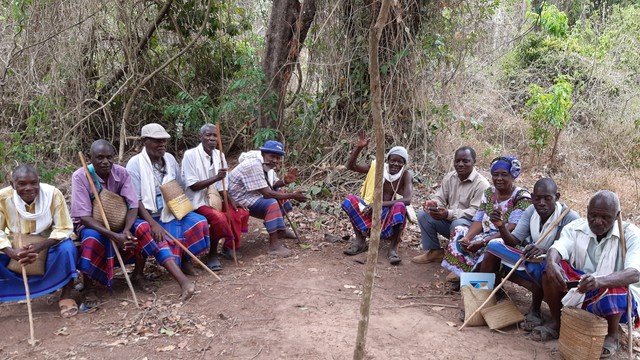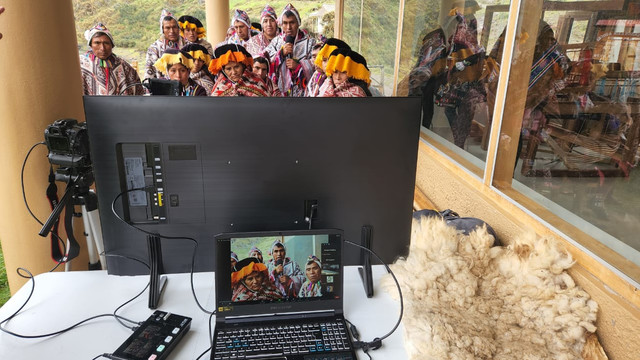Patently obvious: intellectual property rights could support small producers
Small producers sustaining rich agricultural biodiversity in developing countries are struggling to compete and survive. Are Geographical Indications and trademarks a way forward?

The humble potato is a great example of how Quechua communities in the Andes have maintained crop biodiversity. Generations of farmers have developed thousands of potato varieties, with farmers cultivating up to 50 potato varieties on just one farm.
Small producers in developing countries often sustain rich agricultural biodiversity and traditional knowledge and practices through their production systems. Yet, in a world of globalised markets and industrial agriculture, these producers and their biocultural heritage are struggling to compete and survive.
Intellectual property rights are typically used by large and powerful companies which have the capacity to acquire these rights and enforce them in courts to maximize income. But could they in fact be used by small-scale producers to protect products based on collectively held biocultural heritage, such as traditional foods, medicines and handicrafts?
Geographical Indications and trademarks: a way forward?
A new report, published by IIED’s Shaping Sustainable Markets initiative, explores this question.
Particular forms of intellectual property – like geographical indications (GIs) and trademarks – can be held collectively by groups or associations of small producers. GIs identify a product as coming from a region or locality in a particular country. For a GI product, its reputation for quality or authenticity is strongly linked to its geographical origin. Well known examples include Darjeeling tea from India, Parma Ham from Italy and Champagne from France.
Trademarks are distinctive signs, which communicate information to consumers concerning products carrying the mark, such as their business origin and characteristics. Often, a trademark has a single owner. But ownership of a trademark may be shared by a group of producers, each of whom have the right to use the mark – these are known as collective marks. Ethiopia, for example, has trademarked some of its most well known coffees enabling small-scale farmers and traders to capture a greater share of their value.
Protection from unfair competition may provide some assistance for small producers where competitors commit acts of bad faith. If, for example, a competitor falsely claims that their product is from a particular region with particular characteristics, and if consumers are misled by this information, unfair competition law could be used to punish the imitator. All WTO members are obliged to adopt compatible national legislation for unfair competition. However, while this area of law offers potential for small producers it remains poorly developed in developing countries.
Small-scale agricultural and foodstuff producers in Europe – like makers of Italian Parmigiano Reggiano and Parma hams or Scotch Whiskey – have found that both GIs and trademarks have helped to protect and promote traditional products and production methods. Europe’s experience is generally a positive one, but what about developing country producers?
Success stories from the south
Some intellectual property right success stories from developing countries do exist. Darjeeling tea, for example, is grown across 87 plantations and 17,500 hectares in India. Ten million kilograms are produced each year, 70-80% of which is exported – earning the country approximately US$30 million a year [Link is to a PDF: Figure on page 154].
Jamaican Blue Mountain coffee is estimated to be grown by 7,700 farmers across 5000 hectares, 97% of whom are farming small plots of land. It has found a big market in Japan – 83% of its coffee is exported there. In the period 2000 to 2005 the average yearly value of trade in Jamaican Blue Mountain coffee was US$26 million [PDF: Figure on page 170-172].
But, these are prestigious products with a history of goodwill and profitable exports pre-dating their GI status. And, in some cases, production and supply is dominated by large firms and these are able to capture most of the value. By contrast, for small-scale and widely-dispersed producers setting the geographical boundaries of where the product is and can be grown, setting product standards (like how a product should be grown), organising producers, and establishing quality-control measures can be difficult.
Intellectual Property mechanisms need to suit the contexts in which they are applied. The very narrow definition of a product, can lead to the abandonment of other plant varieties, thereby undermining biodiversity conservation. For example, in the case of 100 per cent blue agave tequila, a single plant variety is mentioned in the GI specification. Because of this, other tequila plant varieties have fallen into disuse in large areas of Mexico.
Achieving appropriate Intellectual Property design may be a significant challenge for developing countries and producers, requiring:
- strong organisational and institutional structures to maintain, market and monitor the geographical indication of the product,
- equitable participation among producers and enterprises in a region,
- strong market partners (for producers) who can help to promote and market biocultural products over the long term,
- effective legal protection in the producers’ own country.
Governance of the intellectual property right, and the distribution of costs, benefits and risks among different stakeholders, is also very important. If powerful players – such as large producers, processors or exporters, dominate a GI, the poorest producers can be excluded. In this case, a badly designed GI would be worse than having no GI at all.
While Intellectual Property rights can add value to local biodiversity, they do not automatically encourage the sustainable management of natural resources. Other factors, such as land rights, play an important role in determining the management of natural resources. Methods for local conflict resolution and to ensure equitable governance over the land and products will also play a big role in helping communities of small producers manage the use of Intellectual Property rights.
But, with careful design and use, GIs and trademarks have the potential to benefit indigenous communities and small producers.
This blog was written by Emma Blackmore, Researcher and coordinator of Shaping Sustainable Markets at the Sustainable Markets Group and Krystyna Swiderska Senior Researcher in IIED's Natural Resources Group.
Find out more
Read the briefing: Intellectual property tools for products based on biocultural heritage



